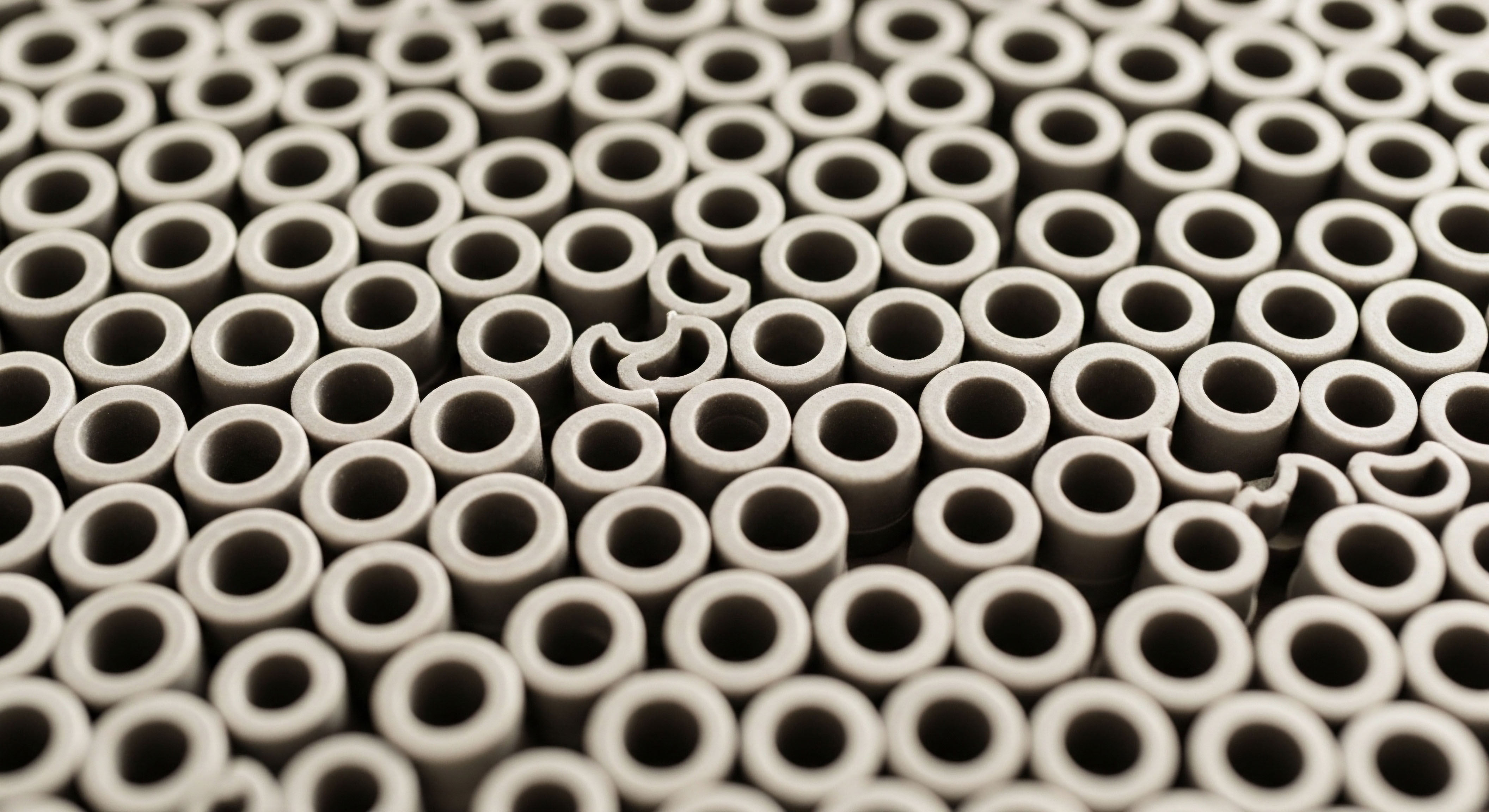

Fundamentals
Beginning a protocol of testosterone replacement therapy (TRT) marks a significant step toward reclaiming your vitality. You may have arrived here after experiencing a constellation of symptoms ∞ persistent fatigue, a fog obscuring your mental clarity, a decline in physical strength, or a muted sense of well-being. These are tangible, valid experiences.
The decision to start hormonal optimization is often born from a deep-seated desire to feel like yourself again. The science of TRT provides a powerful intervention to restore a key physiological component, yet its long-term success is profoundly shaped by the biological environment in which it operates. Your daily choices regarding diet and stress management are the primary architects of this internal environment.
The human body functions as an intricate, interconnected system. At the center of your hormonal universe are two critical communication networks ∞ the Hypothalamic-Pituitary-Gonadal (HPG) axis and the Hypothalamic-Pituitary-Adrenal (HPA) axis. The HPG axis is the command line for sex hormone production; your brain (hypothalamus and pituitary) sends signals to your gonads (testes) to produce testosterone.
This is the system that TRT directly supports when natural production falters. Concurrently, the HPA axis governs your stress response. When you encounter a stressor, your brain signals your adrenal glands to release cortisol. In a balanced state, these two axes work in concert, managing everything from your energy levels and mood to your reproductive health and immune function.

The Interplay of Hormonal Systems
Chronic stress or a diet high in processed foods and refined sugars introduces a state of persistent alarm within the body. This sustained activation of the HPA axis leads to chronically elevated cortisol levels. Cortisol is a catabolic hormone, meaning it breaks things down for immediate energy.
Testosterone, in contrast, is an anabolic hormone, responsible for building and repairing tissues. These two hormones have an inverse relationship. When cortisol is perpetually high, it actively suppresses the function of the HPG axis. This means your body’s own testosterone production is downregulated, and the entire system becomes less sensitive to hormonal signals.
Introducing therapeutic testosterone into this environment is like trying to have a conversation in a loud, crowded room. The message is being sent, but the background noise of high cortisol and systemic inflammation makes it difficult for the body’s cells to receive it clearly.
Your lifestyle choices directly influence the hormonal signaling environment that determines how effectively your body utilizes therapeutic testosterone.
Similarly, your dietary patterns create the foundational building blocks for your health. A diet rich in nutrient-dense whole foods provides the vitamins, minerals, and healthy fats necessary for hormone production and cellular repair. Conversely, a diet dominated by inflammatory foods contributes to a condition known as insulin resistance.
Insulin is the hormone that manages blood sugar, and when cells become resistant to its effects, the body produces more and more of it to compensate. This state of high insulin has direct consequences for testosterone efficacy. It can lower levels of Sex Hormone-Binding Globulin (SHBG), a protein that transports testosterone in the bloodstream.
While this might initially increase “free” testosterone, it also leads to faster clearance and more erratic hormonal fluctuations. High insulin also promotes the activity of an enzyme called aromatase, which converts testosterone into estrogen. This conversion can disrupt the delicate balance of androgens and estrogens, potentially undermining the benefits of your therapy and contributing to unwanted side effects.
Understanding these connections is the first step in moving from a passive recipient of a treatment to an active participant in your own wellness protocol. Your TRT is a specific and targeted intervention. Your lifestyle provides the systemic support that allows this intervention to achieve its full potential over the long term. By managing stress and optimizing nutrition, you are not just adding beneficial habits; you are fundamentally improving the physiological terrain upon which your hormonal health is built.


Intermediate
To appreciate the profound influence of diet and stress on hormonal optimization protocols, we must examine the specific biochemical mechanisms at play. The efficacy of Testosterone Replacement Therapy is modulated by a series of molecular interactions that are directly influenced by your metabolic and adrenal status.
When these systems are dysregulated, they can actively work against the goals of your therapy, requiring higher doses, more frequent adjustments, and a constant battle against side effects. A well-formulated lifestyle strategy becomes a form of biochemical recalibration, creating a synergistic effect with your prescribed protocol.

Metabolic Health and Aromatase Regulation
One of the most significant factors determining the outcome of TRT is metabolic health, specifically insulin sensitivity. A diet high in refined carbohydrates and processed foods drives chronic hyperinsulinemia, or persistently high levels of insulin. This state directly impacts two key variables in testosterone metabolism ∞ Sex Hormone-Binding Globulin (SHBG) and the aromatase enzyme.
SHBG is a protein produced primarily in the liver that binds to sex hormones, including testosterone, and transports them through the bloodstream. When testosterone is bound to SHBG, it is inactive and protected from breaking down. Only “free” testosterone can bind to androgen receptors and exert its effects.
High insulin levels suppress SHBG production. This leads to a lower total testosterone level and a higher percentage of free testosterone. While this may seem beneficial, it often results in a less stable hormonal environment. The body clears the unbound testosterone more rapidly, leading to peaks and troughs that can manifest as mood swings or inconsistent energy levels. It creates a situation where the administered testosterone is used up or converted too quickly.
Simultaneously, hyperinsulinemia and the associated increase in adipose (fat) tissue promote the activity of aromatase. This enzyme is responsible for converting androgens (testosterone) into estrogens. While some estrogen is necessary for male health, an elevated rate of aromatization can lead to an imbalanced testosterone-to-estrogen ratio.
This imbalance is a primary driver of common TRT side effects such as water retention, gynecomastia, and emotional over-reactivity. Men on TRT who struggle with elevated estrogen often find that addressing insulin resistance through dietary changes can be as effective, or even more so, than increasing their dose of an aromatase inhibitor like Anastrozole. By improving insulin sensitivity, you reduce the stimulus for aromatase activity at its source.

What Are the Direct Effects of Diet on Hormonal Markers?
The composition of your diet sends constant signals to your endocrine system. An anti-inflammatory, nutrient-dense diet creates a favorable hormonal milieu, while a pro-inflammatory diet does the opposite. The table below illustrates these contrasting effects.
| Dietary Component | Pro-Inflammatory Diet (High in Processed Foods, Sugar, Unhealthy Fats) | Anti-Inflammatory Diet (Rich in Whole Foods, Fiber, Healthy Fats, Protein) |
|---|---|---|
| Insulin Levels |
Chronically elevated, promoting insulin resistance. |
Stable, promoting insulin sensitivity. |
| SHBG Production |
Suppressed, leading to lower total testosterone and hormonal instability. |
Supported, leading to stable transport and availability of testosterone. |
| Aromatase Activity |
Increased, leading to higher conversion of testosterone to estrogen. |
Modulated, helping to maintain a healthy testosterone-to-estrogen ratio. |
| Systemic Inflammation (e.g. C-Reactive Protein) |
Elevated, contributing to receptor site insensitivity. |
Lowered, improving cellular responsiveness to hormones. |

The Cortisol Connection and Pregnenolone Steal
Chronic stress places a heavy burden on the adrenal glands, leading to sustained high levels of cortisol. This has direct implications for testosterone. Cortisol and testosterone are both steroid hormones, and their relationship is inherently antagonistic. High cortisol signals a state of emergency, prompting the body to break down muscle tissue for energy ∞ the opposite of testosterone’s anabolic function.
Research shows that elevated cortisol can directly suppress the signaling from the pituitary gland that stimulates testosterone production. For an individual on TRT, this means your therapy is working against a strong catabolic current.
Managing stress is a non-negotiable component of successful long-term hormonal optimization, as chronic stress biochemically antagonizes the actions of testosterone.
A more nuanced concept is the “pregnenolone steal” or, more accurately, the preferential pathway diversion. Pregnenolone is a precursor hormone from which the body can synthesize both cortisol and sex hormones like DHEA and testosterone. Under conditions of chronic stress, the biochemical machinery prioritizes the production of cortisol to meet the perceived demand.
This shunts the available pregnenolone down the adrenal pathway, leaving fewer resources available for the production of other essential hormones. While TRT provides an external source of testosterone, this underlying depletion of precursor molecules can still affect the overall hormonal symphony, impacting DHEA levels and other neurosteroids that contribute to a sense of well-being.
Effective stress management techniques are therefore critical. These are not passive relaxation activities; they are active interventions to downregulate the HPA axis and lower cortisol production. A commitment to these practices can profoundly alter your internal biochemistry, making your body more receptive to TRT.
- Mindfulness and Meditation ∞ Practices that train the brain to shift from a reactive to a responsive state can lower baseline cortisol levels and improve the resilience of the HPA axis.
- Controlled Breathing ∞ Slow, diaphragmatic breathing activates the parasympathetic nervous system, the body’s “rest and digest” system, which directly counteracts the “fight or flight” response driven by cortisol.
- Adequate Sleep ∞ Sleep is when the body repairs itself and hormonal regulation occurs. Chronic sleep deprivation is a significant physiological stressor that guarantees HPA axis dysregulation. Prioritizing 7-9 hours of quality sleep per night is fundamental.
- Regular Physical Activity ∞ Consistent exercise is an effective way to process stress hormones and improve insulin sensitivity. It’s a dual-purpose tool for optimizing the internal environment for TRT.
By integrating these dietary and stress-management strategies, you are not merely supplementing your TRT protocol. You are creating the physiological conditions necessary for it to work optimally, leading to better outcomes, greater stability, and a more profound restoration of your health and vitality.


Academic
A sophisticated understanding of long-term Testosterone Replacement Therapy efficacy requires moving beyond systemic hormonal levels and investigating the endpoint of all hormonal action ∞ the receptor site. The success of any hormonal protocol is ultimately determined by the density, sensitivity, and transcriptional activity of its corresponding receptors.
Lifestyle factors, particularly diet-induced metabolic dysfunction and stress-induced adrenal activation, exert a powerful modulatory effect on androgen receptor (AR) function. Systemic inflammation, a common downstream consequence of these factors, appears to be a primary mechanism through which the cellular response to testosterone is blunted, thereby attenuating the clinical benefits of therapy even in the presence of optimized serum androgen levels.

Androgen Receptor Sensitivity and Inflammatory Crosstalk
The androgen receptor is a nuclear hormone receptor that, upon binding with testosterone or its more potent metabolite dihydrotestosterone (DHT), acts as a transcription factor, regulating the expression of hundreds of genes. The clinical effects of TRT ∞ increased muscle mass, improved bone density, enhanced libido, and cognitive benefits ∞ are all mediated by this genomic signaling. However, the cellular environment can significantly alter the AR’s ability to perform this function.
Chronic low-grade inflammation, driven by a pro-inflammatory diet (high in omega-6 fatty acids, refined sugars, and processed components) and psychological stress, is characterized by elevated levels of circulating cytokines such as Tumor Necrosis Factor-alpha (TNF-α) and Interleukin-6 (IL-6). These inflammatory molecules can directly interfere with AR signaling through several pathways:
- Downregulation of AR Expression ∞ Inflammatory signaling pathways, such as the Nuclear Factor-kappa B (NF-κB) pathway, can suppress the gene that codes for the androgen receptor itself. This reduces the total number of receptors available for testosterone to bind to, effectively turning down the volume on the androgenic signal.
- Inhibition of AR Translocation ∞ For the AR to function, it must translocate from the cell’s cytoplasm into the nucleus after binding with testosterone. Inflammatory cytokines can activate kinase enzymes that phosphorylate the AR or its associated proteins, impeding this critical step.
- Interference with Co-activator Proteins ∞ The transcriptional activity of the AR depends on the recruitment of various co-activator proteins. Inflammation can alter the availability or function of these co-activators, uncoupling the testosterone-AR complex from its gene-regulating effects.
This inflammatory-induced AR insensitivity explains a common clinical observation ∞ patients with underlying metabolic syndrome or high levels of chronic stress often report a less robust response to standard TRT protocols. Their serum testosterone levels may be well within the optimal range, yet they fail to achieve the expected improvements in body composition, energy, or well-being. This is because the administered testosterone is unable to effectively communicate its message at the cellular level.

How Does Metabolic Endotoxemia Impair TRT Outcomes?
A particularly potent driver of this inflammation is metabolic endotoxemia, a condition linked to the Western diet. High-fat, low-fiber diets can compromise the integrity of the gut barrier, allowing bacterial components, specifically lipopolysaccharides (LPS), to “leak” into the bloodstream.
LPS is a powerful activator of the innate immune system, triggering a strong inflammatory response via Toll-like receptor 4 (TLR4) and subsequent NF-κB activation. This creates a state of persistent, low-grade systemic inflammation that directly impairs AR function, providing a clear mechanistic link between a poor diet and suboptimal TRT efficacy.
The sensitivity of androgen receptors at the cellular level, which is heavily influenced by inflammation from diet and stress, is the ultimate determinant of TRT success.

The HPA Axis, Glucocorticoid Receptors, and Genomic Competition
The interaction between stress and testosterone extends to the genomic level. Cortisol exerts its effects by binding to the glucocorticoid receptor (GR). Both the androgen receptor and the glucocorticoid receptor are members of the steroid receptor superfamily and recognize similar DNA sequences known as hormone response elements (HREs) on the genes they regulate.
When cortisol levels are chronically elevated, the activated GRs can compete with ARs for binding to these HREs on certain genes. In many cases, the binding of the GR has an inhibitory or opposing effect to that of the AR.
For instance, in muscle cells, the AR promotes genes for protein synthesis, while the GR promotes genes for protein breakdown (proteolysis). This creates a direct genomic conflict where the catabolic signaling of cortisol can override the anabolic signaling of testosterone, limiting the potential for muscle growth and repair even with supraphysiological levels of testosterone.

Can TRT Itself Modulate the Stress Response System?
The relationship is bidirectional. Studies have investigated whether TRT can modulate the HPA axis. The evidence suggests a complex, dose-dependent interaction. Some research indicates that testosterone administration can lead to a blunting of the cortisol response to a stress stimulus, potentially by reducing the sensitivity of the adrenal glands to ACTH.
This suggests that by restoring testosterone to a healthy physiological range, TRT may help to recalibrate a hypersensitive stress response. The table below summarizes findings from various studies on the testosterone-cortisol interaction.
| Study Focus | Key Findings | Clinical Implication |
|---|---|---|
| TRT and ACTH Challenge |
Men on TRT showed a blunted cortisol output in response to a corticotropin-releasing hormone stimulus, despite a normal or even elevated ACTH response. |
Testosterone may directly modulate adrenal sensitivity, potentially protecting against excessive cortisol production. |
| Chronic Stress and HPT Axis |
Sustained high cortisol levels are shown to suppress GnRH release from the hypothalamus and LH from the pituitary, inhibiting endogenous testosterone production. |
Chronic stress creates a suppressive hormonal environment that TRT must overcome. |
| Testosterone and Mood Regulation |
Optimized testosterone levels are associated with improved mood stability and a greater capacity to handle stress, potentially by modulating neurotransmitter systems in the brain. |
TRT can enhance emotional resilience, which in turn helps to mitigate the negative feedback loop of stress on the endocrine system. |
| Metabolic Syndrome and TRT |
In men with type 2 diabetes and hypogonadism, TRT has been shown to improve insulin sensitivity and reduce visceral fat, which are key drivers of inflammation. |
TRT can help break the cycle of metabolic dysfunction, but its effects are amplified when combined with diet and exercise. |
In conclusion, a purely pharmacological view of Testosterone Replacement Therapy is insufficient for ensuring long-term success. The efficacy of the therapy is conditional upon the receptivity of the target tissues, a state that is profoundly influenced by lifestyle-driven factors.
Chronic inflammation from a poor diet and HPA axis hyperactivity from unmanaged stress create a state of functional androgen resistance at the cellular and genomic level. Therefore, clinical protocols that integrate targeted nutritional strategies to improve metabolic health and stress-reduction modalities to normalize HPA function are not adjunctive. They are fundamental to allowing the full therapeutic potential of testosterone to be expressed.

References
- Kapoor, D. Goodwin, E. Channer, K. S. & Jones, T. H. (2006). Testosterone replacement therapy improves insulin resistance, glycaemic control, visceral adiposity and hypercholesterolaemia in hypogonadal men with type 2 diabetes. European Journal of Endocrinology, 154(6), 899 ∞ 906.
- Whirledge, S. & Cidlowski, J. A. (2010). Glucocorticoids, stress, and fertility. Minerva endocrinologica, 35(2), 109 ∞ 125.
- Corona, G. Rastrelli, G. & Maggi, M. (2013). Testosterone replacement therapy ∞ long-term safety and efficacy. The journal of sexual medicine, 10(3), 639-57.
- Amanatkar, H. R. & Zafari, M. (2014). The benefits and risks of testosterone replacement therapy ∞ a review. Translational Andrology and Urology, 3(3), 427-448.
- Rubinow, D. R. & Schmidt, P. J. (2019). Testosterone and Cortisol ∞ A role for the HPA axis in the pathophysiology of male depression?. Psychoneuroendocrinology, 107, 289-297.
- Dandona, P. Dhindsa, S. Chaudhuri, A. Bhatia, V. & Topiwala, S. (2008). Insulin resistance and inflammation in hypogonadotropic hypogonadism and their reduction after testosterone replacement in men with type 2 diabetes. Diabetes care, 31(7), 1462-1467.
- Traish, A. M. (2014). Testosterone and weight loss ∞ the evidence. Current opinion in endocrinology, diabetes, and obesity, 21(5), 313 ∞ 322.

Reflection
The information presented here provides a biological and physiological map. It details the intricate connections between your choices, your internal chemistry, and the effectiveness of your therapy. The true application of this knowledge, however, begins with introspection. Consider the signals your own body is sending.
Where in your daily life does stress manifest most acutely? What patterns exist in your nutritional habits, and how do they correlate with your energy levels and sense of well-being? This clinical science is most powerful when it is used as a lens through which to view your own lived experience.
The path to sustained vitality is one of active, informed participation. Your protocol is a cornerstone, and your lifestyle is the architecture you build upon it, day by day.



